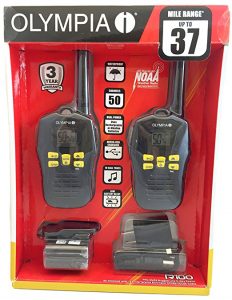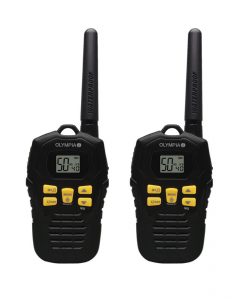Olympia R100 Review
Ratings
-
Design - 9.2/10
9.2/10
-
Features - 9/10
9/10
-
Range and Sound Clarity - 9/10
9/10
-
Price - 8.5/10
8.5/10
The Olympia R-100 claim to be a rugged walkie talkie which can handle up to 42 miles of range, depending on the model that you order. Recently, there has been an influx of ruggedized and waterproof products in the market. One of the great things about a rugged product is that you can drop it without worrying that it will break. Olympia is so confident in the ruggedness, that they have even thrown in three years of warranty with every single purchase of this unit.
Check lowest price:
Box
The box contains one radio per box, with two AA NiMH rechargeable batteries and a charging stand. There is a user guide as well, but the quality of the paper is terrible and the font size is really small. I’ll take a pass on that and dive right in instead.
Construction
This device feels quite heavy in the hand, and a lot of shoppers on Amazon have complained about how heavy this walkie talkie is. However, weight is a subjective issue. I personally don’t mind the extra weight at all, in fact, I love it. The device feels like a brick in your hand, and such design inspires confidence that a few tumbles on a concrete platform won’t even scratch this thing.
As is the case with most rugged devices, you will find a lot of rubber being used in the construction of this unit. Almost the entire unit has a premium rubber like finish. Thick rubber absorbs shocks, reducing the impact on the key parts of the walkie talkie when it falls down. The buttons are solid and are also made of some form of rubber. The buttons are not clicky, instead, you know you are holding them down.
Features
The walkie talkie supports the open source CHIRP software and also has a micro USB port, which is the charging port, so you can program this radio manually if you so wish to do. The walkie talkie also includes 10 NOAA weather channels, so if you are outside, you can hear about the weather if you wish to. The radio pretty much works as described, nothing less and nothing more.
The speaker on this device is really loud. One can easily hear someone over the speaker even in a large noisy crowd. Many manufacturers cheap out on speakers so that the customers spend more money on a headset. There is a ring and vibrate mode as well when the walkie talkie rings. This is helpful if your walkie talkie is clipped to your belt.
Waterproofing
This radio is waterproof to IP-67 standards. It will withstand submersion under up to 1 meter of water for up to 30 minutes. The radio is resistant to water, rain, and splashes only when the battery cover and headset accessory port are sealed. Open the battery compartment door or headset port cover only when the radio is dry. Use of a headset accessory should be in dry environments only.
Downsides
Unfortunately, the radio has to be turned off to charge. Perhaps the charger does not put out enough power to run the radio and keep it charged. The range is also really poor on this thing. The weight might be a downside to a lot of users, even if it is not to me. The user guide tells you almost nothing about what is to be done, it is printed on a font which seems like it is 4 px in size. It is simply not possible to read any of it.
Licensing and Bands
Unless you get an amateur license and buy ham gear or commercial grade handhelds, this is your best option. A license is required in the USA for GMRS channels. This walkie talkie puts out .5 watts on FRS channels, and 1.5 watts on GMRS channels. That is sufficient to transmit 40 miles line of sight. The only way that can happen is if each operator is on a mountain top with no obstructions. People routinely talk via amateur radio to the space station 240 miles above the earth on 5 watts handheld radios.
The radio doesn’t really have “50 channels”. It has the FRS channels (8-14) and four “privacy coded” FRS channels (34-37). The remaining channels to reach the 50 are a mix of coded and non-coded GMRS channels. In addition, there are eight duplex channels (GMRS) with standard repeater offsets. If that’s of interest, you could learn about it and get the no test GMRS license.
Range
The range is entirely dependent on what is obstructing or absorbing the signal. However, without more power, or better antennas, it is what it is. FRS requires no license and has slightly less transmitting power, so the distance should be less. GMRS has more power and they want you to have a license, or else you might face a fine. Distances are not far unless you have no obstacles or local repeaters. This is what’s nice about these radios. They are one of very few which can be programmed to hit the repeaters. Programming is done right on the radio easily, without any software. There is no need to take them to anyone to program as there is no need of cords, computer or software in order to program it! This radio can get long distances on a repeater in emergencies. If you don’t have repeaters available, you could just buy any radio. In real world conditions, I think 10mi is the best you can hope, at least from what I tested. I have tested this in urban settings, and 3miles in good conditions is my best so far
Conclusion
If you are keen on buying a rugged walkie talkie for some heavy-handed use, you don’t really need to look any further, this is the right one for you. However, if you are looking for something with very good range then you are looking at the wrong product. One of the great things about this is that it can be programmed from the walkie talkie itself, and this is very encouraging to see.


